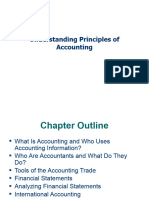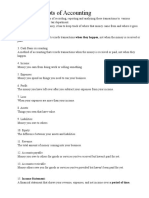Module 1
Uploaded by
educassistteamModule 1
Uploaded by
educassistteamModule 1
Introduction to Bookkeeping:
1-Basics of Bookkeeping:
Bookkeeping is the systematic recording, organizing, and managing
of financial transactions and data in a business or organization. It
serves as the foundation for more complex financial reporting and
accounting, allowing businesses to track their income and
expenditures and how much they own (assets) versus how much
they owe (liabilities). Here are some key concepts, principles, and
components that form the basis of bookkeeping:
Key Concepts of Bookkeeping
1. Double-Entry System:
o This is the fundamental principle of bookkeeping where
every financial transaction affects at least two accounts.
For every debit entry, there must be an equal credit
entry, which ensures the accounting equation (Assets =
Liabilities + Equity) remains balanced.
2. Accounts:
o Accounts are categories where transactions are recorded.
Major types of accounts include:
Assets: Resources owned by the business (e.g.,
cash, inventory, equipment)
Liabilities: Obligations the business owes to others
(e.g., loans, accounts payable)
Equity: The owner’s interest in the business (e.g.,
common stock, retained earnings)
Revenue: Earnings from sales of goods or services
Expenses: Costs incurred in the process of earning
revenue
3. Journal Entries:
o Transactions are initially recorded in a journal. Each
journal entry includes the date, accounts affected,
amounts to be debited and credited, and a brief
description of the transaction.
4. Ledger:
o After journal entries are recorded, they are posted to
ledgers, which are collections of accounts. This allows for
an organized view of all transactions related to each
account.
5. Trial Balance:
o A trial balance is prepared at the end of an accounting
period to ensure that total debits equal total credits. It is
a way to check the accuracy of the bookkeeping entries.
6. Financial Statements:
o After bookkeeping activities are complete, financial
statements are prepared to summarize the financial
activities of the business. The key financial statements
include:
Income Statement: Summarizes revenues and
expenses over a specific period, showing profit or
loss.
Balance Sheet: Presents the financial position of a
business at a specific point in time, detailing assets,
liabilities, and equity.
Cash Flow Statement: Shows the inflow and outflow
of cash, providing insight into liquidity.
Basic Bookkeeping Procedures
1. Identify Transactions:
o Recognizing and determining what constitutes a financial
transaction that needs to be recorded.
2. Document Transactions:
o Collecting and organizing all source documents (receipts,
invoices, bank statements) that serve as evidence of
transactions.
3. Record Transactions:
o Entering transactions in the journal with appropriate
debits and credits.
4. Post to Ledger:
o Transfer journal entries to respective accounts in the
ledger.
5. Prepare Trial Balance:
o Compile a trial balance to ensure that the books are
balanced.
6. Adjust Entries:
o At the end of an accounting period, necessary
adjustments may be made to account for accrued and
deferred items.
7. Generate Financial Statements:
o Prepare financial statements that present the business’s
financial performance and position to stakeholders.
Importance of Bookkeeping
1. Financial Management: Accurate bookkeeping provides
insights into financial health, enabling better decision-making.
2. Tax Compliance: Proper records are essential for preparing
tax returns and ensuring compliance with tax regulations.
3. Business Planning: Financial reports derived from
bookkeeping can assist in budgeting and forecasting future
financial performance.
4. Audit Preparedness: Well-maintained records facilitate
smooth audits by external entities.
5. Cash Flow Management: Tracking income and expenses can
help manage cash flows and identify financial bottlenecks.
Tools and Software
In modern bookkeeping, various tools and software, such as
QuickBooks, Xero, and FreshBooks, are used to automate tasks,
improve accuracy, and provide real-time financial reporting. These
tools help streamline the bookkeeping process, making it more
efficient and accessible, especially for small businesses.
Understanding the basis of bookkeeping is crucial for maintaining
accurate financial records and ensuring the long-term success of an
organization. Effective bookkeeping practices contribute to informed
decision-making, strategic planning, and overall financial stability.
2- Understand Financial Document:
Understanding financial documents is essential for making informed
decisions in both personal and business contexts. Here are some
key types of financial documents and concepts to help you navigate
them:
Types of Financial Documents:
1. Income Statement:
o Definition: A financial statement that shows a company's
revenues and expenses over a specific period, resulting in
net profit or loss.
o Key Components:
Revenues (Sales)
Cost of Goods Sold (COGS)
Gross Profit
Operating Expenses (Selling, General &
Administrative expenses)
Net Income
2. Balance Sheet:
o Definition: A snapshot of a company's financial position
at a specific point in time, outlining assets, liabilities, and
equity.
o Key Components:
Assets (Current and Non-Current)
Liabilities (Current and Long-Term)
Shareholders' Equity
3. Cash Flow Statement:
o Definition: A financial document that provides aggregate
data regarding all cash inflows and outflows a company
receives.
o Key Sections:
Operating Activities
Investing Activities
Financing Activities
4. Statement of Shareholders' Equity:
o Definition: This statement outlines changes in equity
from the end of one fiscal period to the end of the next.
o Key Components:
Common Stock
Retained Earnings
Treasury Stock
5. Financial Ratios:
o Definition: Metrics used to evaluate a company's
financial performance and condition.
o Common Ratios:
Current Ratio: Current Assets / Current Liabilities
Debt-to-Equity Ratio: Total Liabilities / Shareholders'
Equity
Return on Equity (ROE): Net Income / Shareholders'
Equity
6. Tax Documents:
o Examples: W-2s, 1099s, tax returns, and schedules that
detail income, deductions, and credits.
o Importance: Used for reporting income and calculating
taxes owed or refunds due.
7. Budgets:
o Definition: A financial plan that outlines expected
revenues and expenses over a specified period.
o Purpose: Helps in managing finances and forecasting cash
flow.
Key Concepts:
Accrual vs. Cash Accounting:
o Accrual Accounting: Recognizes revenue and expenses
when they are incurred, regardless of when cash is
exchanged.
o Cash Accounting: Recognizes revenue and expenses
only when cash is received or paid.
Liquidity:
o Refers to how easily assets can be converted into cash.
Profitability:
o Indicates how much profit a company makes relative to
its revenue or assets.
Solvency:
o The ability of a company to meet its long-term debts and
financial obligations.
Tips for Reading Financial Documents:
1. Understand the Layout: Familiarize yourself with the
structure of financial documents. Each one has a standard
format.
2. Focus on Key Figures: Look for revenues, expenses, net
income, total assets, total liabilities, and cash flow from
operations as these figures provide insight into financial health.
3. Compare Periods: Analyze trends over multiple periods to
assess growth, stability, and performance.
4. Calculate Ratios: Use financial ratios to evaluate liquidity,
profitability, and solvency.
5. Read Notes and Footnotes: These provide additional
context and clarification about the numbers presented.
6. Use Software or Tools: Financial analysis software can help
with calculations and visualization of data.
By understanding these financial documents and concepts, you can
gain insights into financial health and performance, whether for
personal finances or for evaluating a business's financial situation.
You might also like
- Fundamental Accounting Principles 25th Edition PDFNo ratings yetFundamental Accounting Principles 25th Edition PDF14 pages
- Financial & Managerial Accounting Week 1No ratings yetFinancial & Managerial Accounting Week 13 pages
- FINANCIAL ACCOUNTING KEY TAKE AWAYS 2024No ratings yetFINANCIAL ACCOUNTING KEY TAKE AWAYS 20245 pages
- IMP. QUES OF FINANCIAL & MANAGEMENT ACCOUNTINGNo ratings yetIMP. QUES OF FINANCIAL & MANAGEMENT ACCOUNTING111 pages
- Understanding Key Concepts For Financial ClarityNo ratings yetUnderstanding Key Concepts For Financial Clarity2 pages
- Everything you need to know about Finance and accountingNo ratings yetEverything you need to know about Finance and accounting5 pages
- Chapter 16 - Understanding Accounting and Financial InformationNo ratings yetChapter 16 - Understanding Accounting and Financial Information6 pages
- Chapter 10 - Understanding financial information and accounting - CopyNo ratings yetChapter 10 - Understanding financial information and accounting - Copy38 pages
- Introduction To Business: Understanding Accounting and Financial InformationNo ratings yetIntroduction To Business: Understanding Accounting and Financial Information9 pages
- Learning Outcomes No L01 L02 L03 L04 L05No ratings yetLearning Outcomes No L01 L02 L03 L04 L0511 pages
- Understanding The Basics of Accounting and Finance0% (1)Understanding The Basics of Accounting and Finance11 pages
- Financial Accounting (BCOC-131) - Block 1 Detailed NotesNo ratings yetFinancial Accounting (BCOC-131) - Block 1 Detailed Notes11 pages
- Key topics covered in Accounting - Introduction by MyburghNo ratings yetKey topics covered in Accounting - Introduction by Myburgh5 pages
- Acct1501 Notes: 1. Introduction To Financial AccountingNo ratings yetAcct1501 Notes: 1. Introduction To Financial Accounting11 pages
- 1 Basic Concepts Overview of Financial AccountingNo ratings yet1 Basic Concepts Overview of Financial Accounting11 pages
- Synthesis Paper - Bookkeeping and Financial StatementsNo ratings yetSynthesis Paper - Bookkeeping and Financial Statements2 pages
- Introduction To Accounting Basic AccountingNo ratings yetIntroduction To Accounting Basic Accounting16 pages
- Finance and Accounting For Non-Financial Managers0% (1)Finance and Accounting For Non-Financial Managers36 pages
- Per Meter Cost Analysis (From Jani) - CanalNo ratings yetPer Meter Cost Analysis (From Jani) - Canal3 pages
- Overview of Mergers and Acquisition and MNo ratings yetOverview of Mergers and Acquisition and M11 pages
- Database Design For Dynamic Online Surveys: Conference PaperNo ratings yetDatabase Design For Dynamic Online Surveys: Conference Paper9 pages
- On Characterizations of NANO RGB-Closed Sets in NANO Topological SpacesNo ratings yetOn Characterizations of NANO RGB-Closed Sets in NANO Topological Spaces9 pages
- Soalan Matematik Tambahan Kertas 1 SABAHNo ratings yetSoalan Matematik Tambahan Kertas 1 SABAH18 pages
- Q1 2023 MAIN Investor Presentation 28th April 2023 Final VersionNo ratings yetQ1 2023 MAIN Investor Presentation 28th April 2023 Final Version35 pages
- J Institute Brewing - January February 1993 - Langstaff - The MOUTHFEEL of BEER A REVIEWNo ratings yetJ Institute Brewing - January February 1993 - Langstaff - The MOUTHFEEL of BEER A REVIEW7 pages
- Fundamental Accounting Principles 25th Edition PDFFundamental Accounting Principles 25th Edition PDF
- Everything you need to know about Finance and accountingEverything you need to know about Finance and accounting
- Chapter 16 - Understanding Accounting and Financial InformationChapter 16 - Understanding Accounting and Financial Information
- Chapter 10 - Understanding financial information and accounting - CopyChapter 10 - Understanding financial information and accounting - Copy
- Introduction To Business: Understanding Accounting and Financial InformationIntroduction To Business: Understanding Accounting and Financial Information
- Understanding The Basics of Accounting and FinanceUnderstanding The Basics of Accounting and Finance
- Financial Accounting (BCOC-131) - Block 1 Detailed NotesFinancial Accounting (BCOC-131) - Block 1 Detailed Notes
- Key topics covered in Accounting - Introduction by MyburghKey topics covered in Accounting - Introduction by Myburgh
- Acct1501 Notes: 1. Introduction To Financial AccountingAcct1501 Notes: 1. Introduction To Financial Accounting
- Synthesis Paper - Bookkeeping and Financial StatementsSynthesis Paper - Bookkeeping and Financial Statements
- Database Design For Dynamic Online Surveys: Conference PaperDatabase Design For Dynamic Online Surveys: Conference Paper
- On Characterizations of NANO RGB-Closed Sets in NANO Topological SpacesOn Characterizations of NANO RGB-Closed Sets in NANO Topological Spaces
- Q1 2023 MAIN Investor Presentation 28th April 2023 Final VersionQ1 2023 MAIN Investor Presentation 28th April 2023 Final Version
- J Institute Brewing - January February 1993 - Langstaff - The MOUTHFEEL of BEER A REVIEWJ Institute Brewing - January February 1993 - Langstaff - The MOUTHFEEL of BEER A REVIEW

























































































